| Author |
Topic: We're Building a REAL Steel Guitar |
Alan Brookes
From:
Brummy living in Southern California
|
 Posted 17 Jul 2009 2:04 pm
Posted 17 Jul 2009 2:04 pm |
|
| Philip Bender wrote: |
| ...In studying your design, I wondered if you could integrate tabs for the nut and bridge to clean up the assembly... |
On the first prototype we did just that. We created a bent strap with two holes to accomodate a tapped rod with rollers to take the strings. Then we decided to integrate that with the fingerboard and do away with the rollers, which would only be needed if you fitted palm levers or a string bender.
Here are some views of the third prototype, which is a 12-string version. Only 6 strings are fitted at this stage, as we need to build some additional support for the machine tuners to prevent early wear.




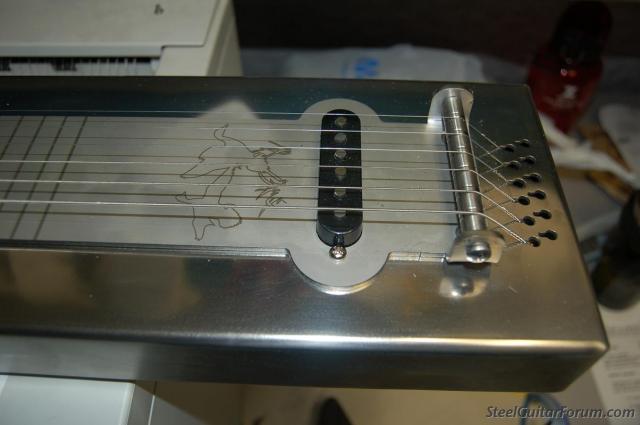
Notice that this version has bird engravings, as opposed to rose engravings on the previous.
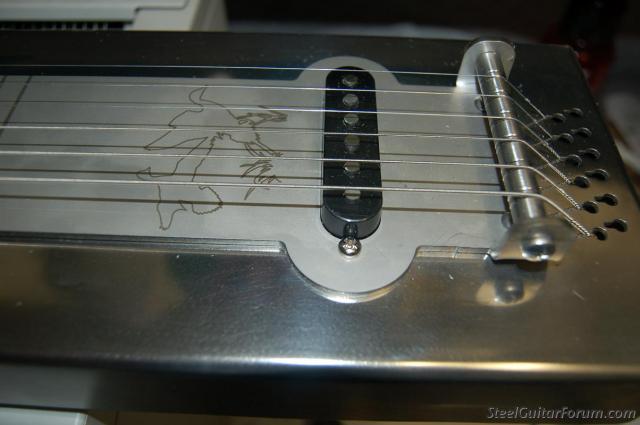
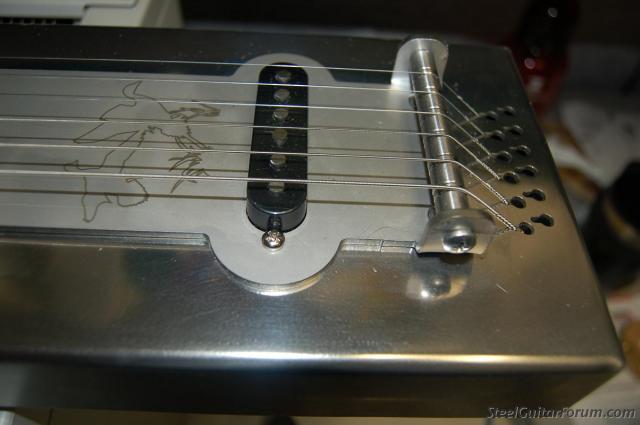
Notice the scalloped end of the fingerboard. Just for decoration. 
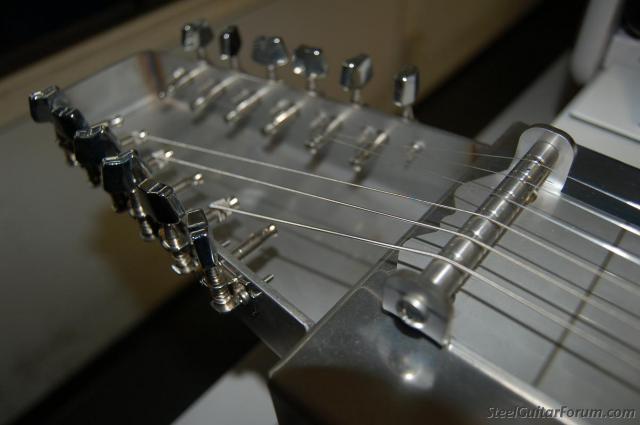
Notice that the tapped rod has now been replaced with machined nut and bridge.
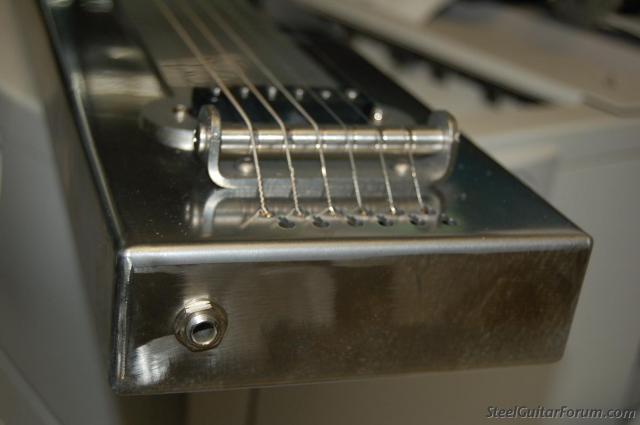
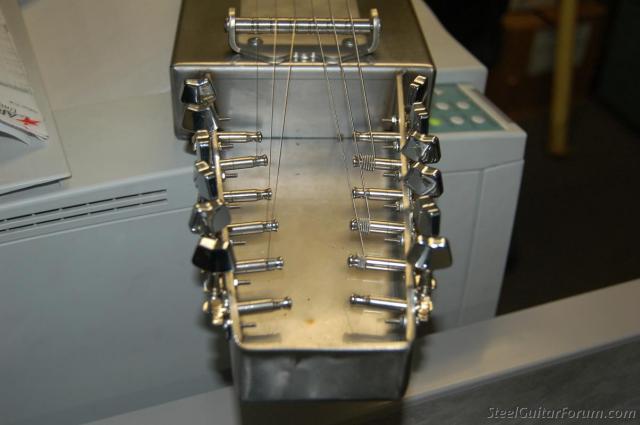
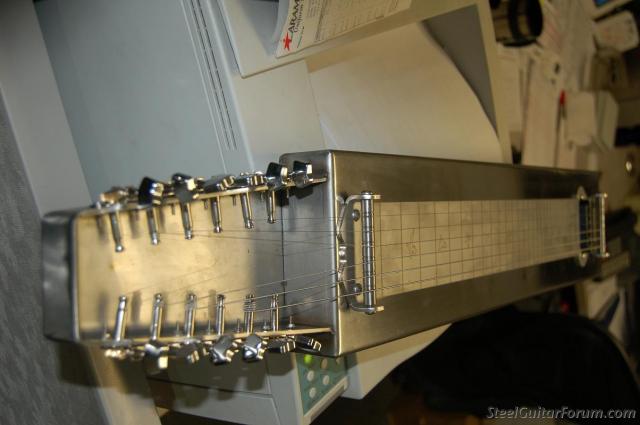
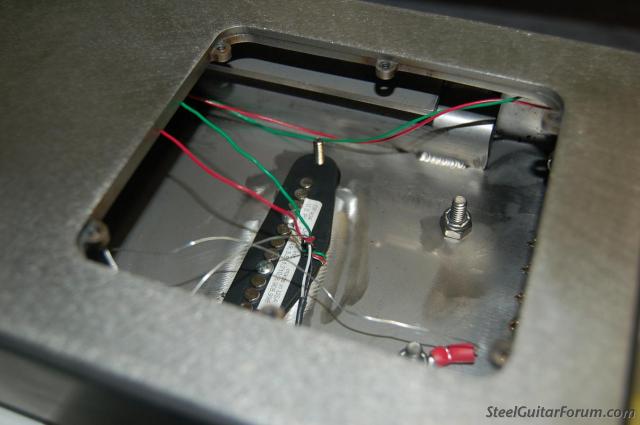
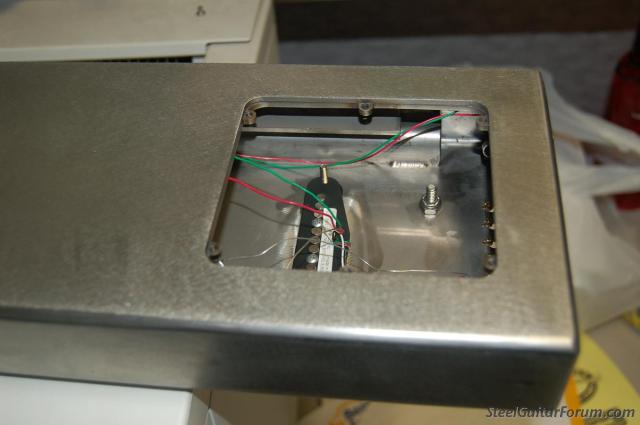
The grommet is to hold the access hole cover.
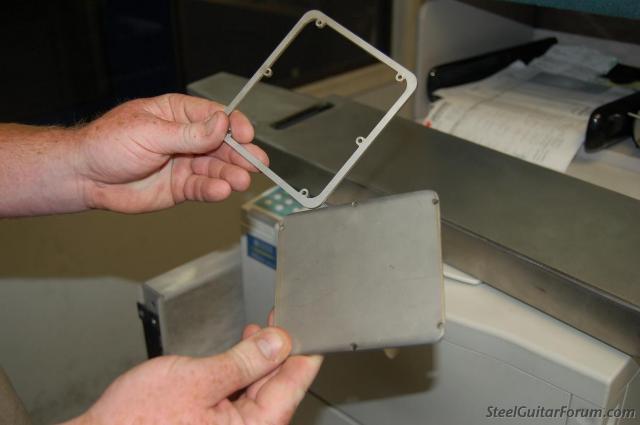
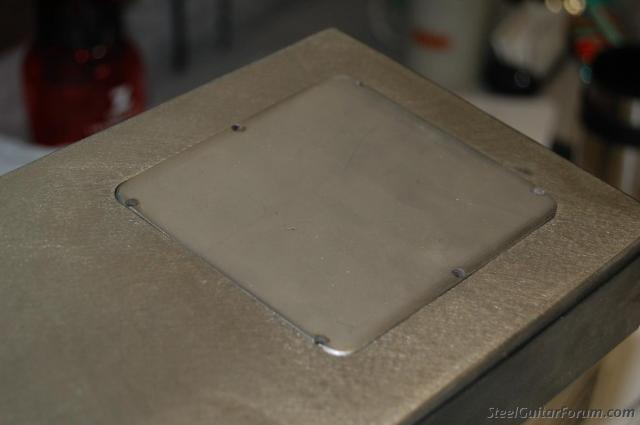
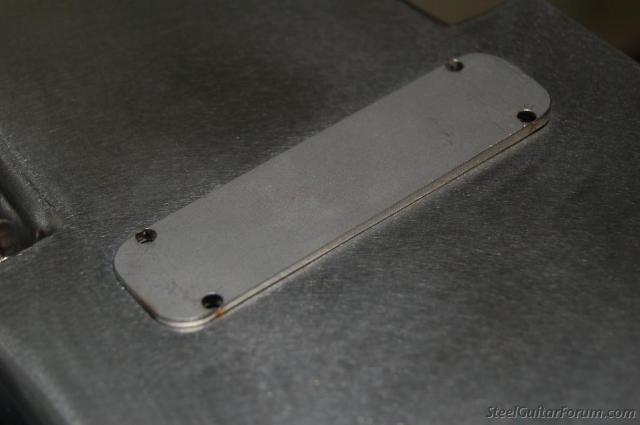
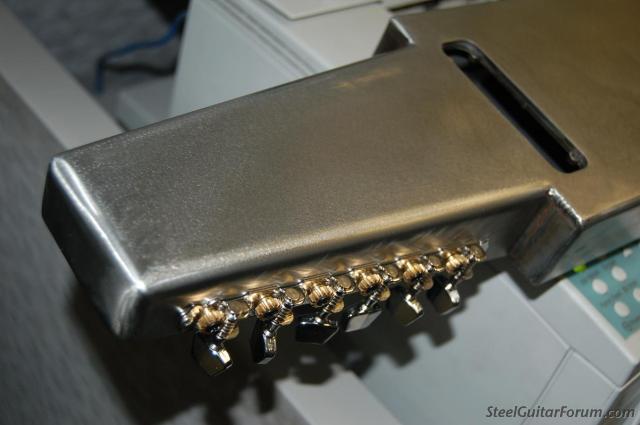

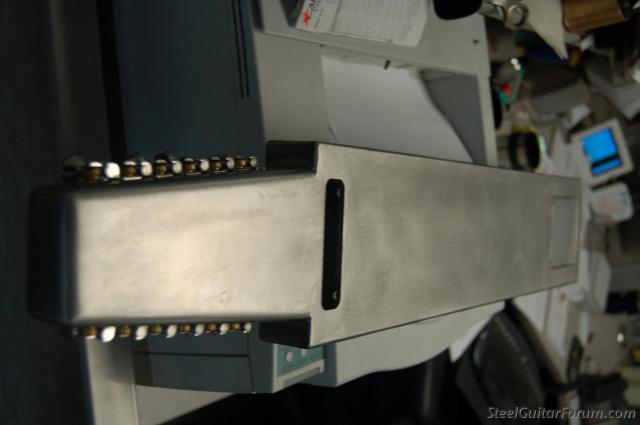
 |
|
|
|
Philip Bender
From:
Palmetto FL USA (deceased)
|
 Posted 19 Jul 2009 5:45 am steel guitar
Posted 19 Jul 2009 5:45 am steel guitar |
|
Aloha Alan,
Could you incorporate a return flange on the tuner section to give you a cover for the screws, and a bearing surface for tuners.
Phil[/url] |
|
|
|
Alan Brookes
From:
Brummy living in Southern California
|
 Posted 19 Jul 2009 9:41 am Re: steel guitar
Posted 19 Jul 2009 9:41 am Re: steel guitar |
|
| Philip Bender wrote: |
Aloha Alan,
Could you incorporate a return flange on the tuner section to give you a cover for the screws, and a bearing surface for tuners.
Phil[/url] |
Yes, that's basically what I meant by, "Only 6 strings are fitted at this stage, as we need to build some additional support for the machine tuners to prevent early wear." The tuners were designed for wood. The steel being much thinner that puts the bending forces back towards the tuner about 3/8", which increases the torque at that fulcrum by about double, and will wear out the gears in no time. We intend to build a second strip, which will be U-shaped, and bend round both sides. We rejected the idea of just doubling back the metal in that area because it still wouldn't give enough thickness to replicate the situation in a wooden machine-head.
When you mention "a cover for the screws", I would be reluctant to cover up the screws, because the instrument is designed for easy access, and you might want to change the tuners. As it is you can strip the thing down to its bare components in minutes. (The longest job would be removing the strings from the rollers.)
We're also thinking of a bridge cover, which could carry our logo, whatever that will be. |
|
|
|
Philip Bender
From:
Palmetto FL USA (deceased)
|
 Posted 22 Jul 2009 1:10 pm Steel guitar
Posted 22 Jul 2009 1:10 pm Steel guitar |
|
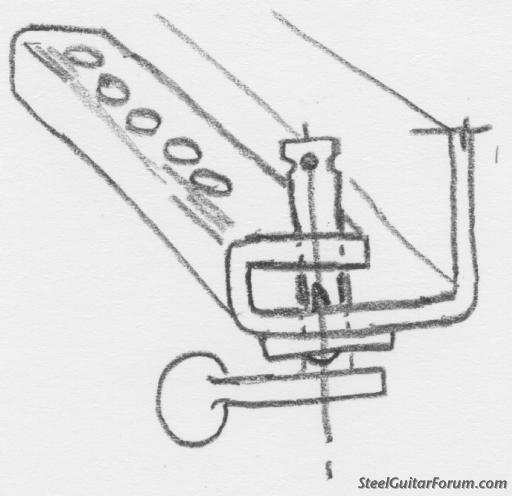
Alan, this is the flange I was talking about, does it make sense to you?
Phil |
|
|
|
Mitch Druckman
From:
Arizona, USA
|
 Posted 22 Jul 2009 7:57 pm
Posted 22 Jul 2009 7:57 pm |
|
| An elegant solution from Mr. "Bender" |
|
|
|
Alan Brookes
From:
Brummy living in Southern California
|
 Posted 23 Jul 2009 7:00 am Re: Steel guitar
Posted 23 Jul 2009 7:00 am Re: Steel guitar |
|
| Philip Bender wrote: |

Alan, this is the flange I was talking about, does it make sense to you?
Phil |
It makes sense, Phil, and this was our first thought. However, we can't physically put all those bends in the metal with our press brake. If you try to make a box-shape, you're okay with the first bend, the second is awkward, but the third bend is impossible as the metal now prevents the machine from getting into place to make the third bend. A flange like you suggest would require a machine that we don't have. Our solution was spacers, as in the following photo...
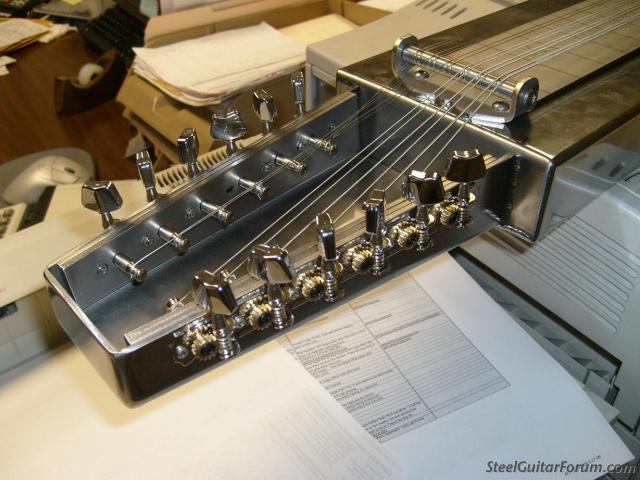
Here's a shot of progress to date...
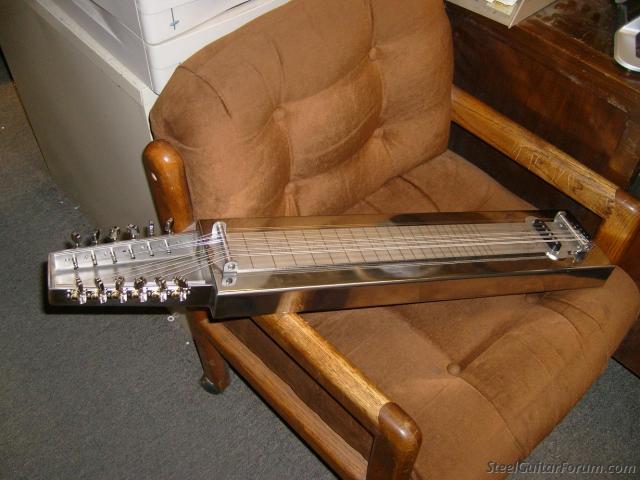 |
|
|
|
James Mayer
From:
back in Portland Oregon, USA (via Arkansas and London, UK)
|
 Posted 23 Jul 2009 9:43 am
Posted 23 Jul 2009 9:43 am |
|
Nice job! I'm curious as to how the doubled strings sound. Why isn't that done more often?
I think the instrument would be more attractive if it wasn't so thick. Maybe 1" instead of 1.5" (I'm just guessing). I would think the strength of steel would mean you could make use a more streamlined body and still maintain rigidity. The fretboard looks fantastic. |
|
|
|
Alan Brookes
From:
Brummy living in Southern California
|
 Posted 23 Jul 2009 2:27 pm
Posted 23 Jul 2009 2:27 pm |
|
| James Mayer wrote: |
Nice job! I'm curious as to how the doubled strings sound. Why isn't that done more often?
I think the instrument would be more attractive if it wasn't so thick. Maybe 1" instead of 1.5" (I'm just guessing). I would think the strength of steel would mean you could make use a more streamlined body and still maintain rigidity. The fretboard looks fantastic. |
I started out building archaic folk instruments, and most of the fretted instruments in mediaeval times had double course. At the time this was because of the vagarity of the strings then available. With gut, it varied from one animal to another, and wasn't uniform along its length, and the same applied to the primitive wire available at the time. So with two strings tuned in unison you had more chance of being in tune. Instruments without frets, such as the viol, didn't need that because the tuning would be made by the player's feel for the strings on the fingerboard.
It has more of a zingy sound in E. I've built several lap steels with double course over the years, and the advantage really comes over with C6 tuning, where those rich chords really boom out as you slide up the strings.
Why isn't it done more often ? Most steel guitarists have never tried a multiple-coursed instrument, so have never had the choice. Those who have probably think that it would limit their playing speed. If you notice, very few jazz guitarists use 12-string guitars. But if you listen to a classical mandolinist playing some of the Beethoven pieces it puts to rest any idea that double courses are an incumbrance. Of course, when double courses have been tried on pedal steels, and I'm thinking now of Sho-Bud, they've encountered enormous problems keeping the pulls the same on the pairs.
About the thickness of the instrument: you're only limited to the space needed for the chord sockets or other switches, and the depth of the pickups. I like to put switches around the front side of the instrument, and the amplifier jack at the rear end. That leaves the front clear for the logo and owner's name. If you used micro switches, or micro jacks you might cut down the thickness a little. Remember the depth of the machine tuners. All in all, the current depth seems about right to me, and I patterned it after the depth of a Fender Stringmaster. |
|
|
|
James Mayer
From:
back in Portland Oregon, USA (via Arkansas and London, UK)
|
 Posted 23 Jul 2009 2:37 pm
Posted 23 Jul 2009 2:37 pm |
|
| I have an oud, a cumbus and a mandola. All of them have doubled courses but very low sustain. I'd really like to hear a some good long sustained notes and chords if you get a chance to record that steel steel. |
|
|
|
Alan Brookes
From:
Brummy living in Southern California
|
 Posted 24 Jul 2009 6:44 am
Posted 24 Jul 2009 6:44 am |
|
| James Mayer wrote: |
| I have an oud, a cumbus and a mandola. All of them have doubled courses but very low sustain... |
Yes, me too. The oud usually has gut or nylon strings, and tends to be played with a lot of stuccato; the cumbus has a vellum, it's basically a metal banjo; and the mandola has a small body; none of which is condusive to sustain. I've often wondered whether the presence of two strings right next to each other on the bridge tend to make the vibrations die out earlier, or reinforce each other. I haven't noticed that a 12-string guitar has greater or lesser sustain than a regular guitar. Some luthiers think that having a common bridge between all the strings means that the vibrations interfere with each other, and so they build six separate bridges. This is, in effect, what the Stratocaster's individual bridge units do, although they're still close to each other on the bridge plate. My thought is that, on an all-metal instrument, the strings should be able to vibrate just as much whether they're next to another or not, because the instrument itself is heavier, and so the natural frequencies of the body will be lower down the scale. We'll see. On the prototype illustrated, it seems to have plenty of sustain.
The sound of a double-course instrument won't be suitable for all applications, of course. Maybe two necks, with one double course, and one single course, would be useful. A few years ago I built a console guitar with two necks.... one was strung in octaves and the other in unison. I'll see if I can get round to recording a demo of that instrument over the weekend.
| James Mayer wrote: |
| ...I'd really like to hear a some good long sustained notes and chords if you get a chance to record that steel steel. |
The one strung-up prototype that we have available at the moment is being used by Tom. He's not played the lap steel before and is getting very enthusiastic, so I want to encourage him. We should have another prototype available within a week, with 7 double courses, set up for C6, and I'll make sure I record something as a demo. (It's not going to sound like Jerry Byrd, of course.   ) ) |
|
|
|
Philip Bender
From:
Palmetto FL USA (deceased)
|
 Posted 26 Jul 2009 1:52 pm steel guitar
Posted 26 Jul 2009 1:52 pm steel guitar |
|
Aloha Alan,
I know this sketch is not to scale, but will this concept explain what I was trying to tell you? If not, I won't bother you with my ideas.
Mahalo,
Phil
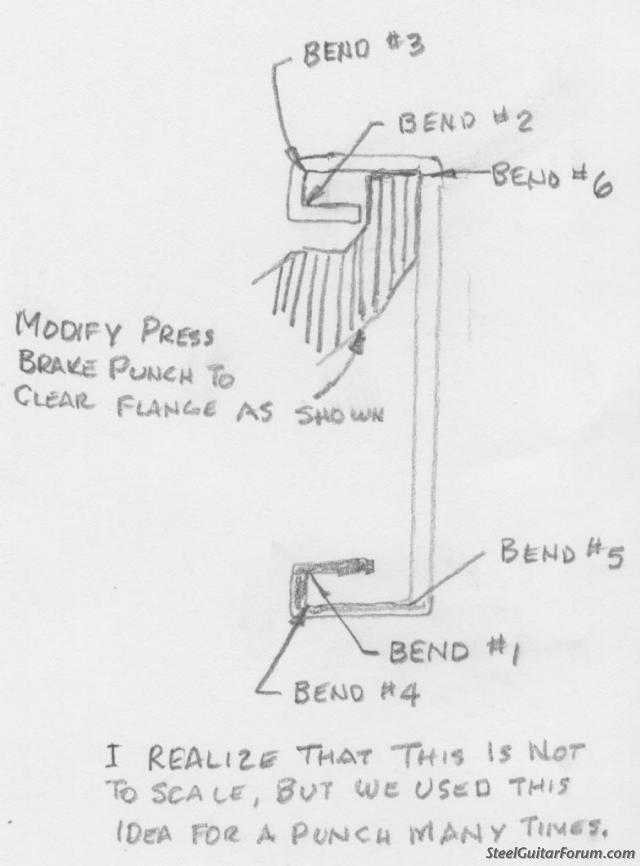 |
|
|
|
Alan Brookes
From:
Brummy living in Southern California
|
 Posted 26 Jul 2009 5:03 pm
Posted 26 Jul 2009 5:03 pm |
|
Thanks Phil. I'll run it by the guy who does the bending. I'm just an accountant.   |
|
|
|
Alan Brookes
From:
Brummy living in Southern California
|
 Posted 27 Jul 2009 6:45 am
Posted 27 Jul 2009 6:45 am |
|
Okay, it's Monday morning now, and I'm back in the office. I printed up your sketch, Phil, and showed it to our engineers. The problem we have is that our press brake is set up to bend much bigger items. We're not a musical instrument company, we're set up to produce 35,000 volt electrical equipment, and we can't invest company money to produce new dies for what is a private project. The smallest die we have for that sort of bend is what you see in the photo below, and it's much too big. Remember that we're doing this project on a next-to-zero budget.
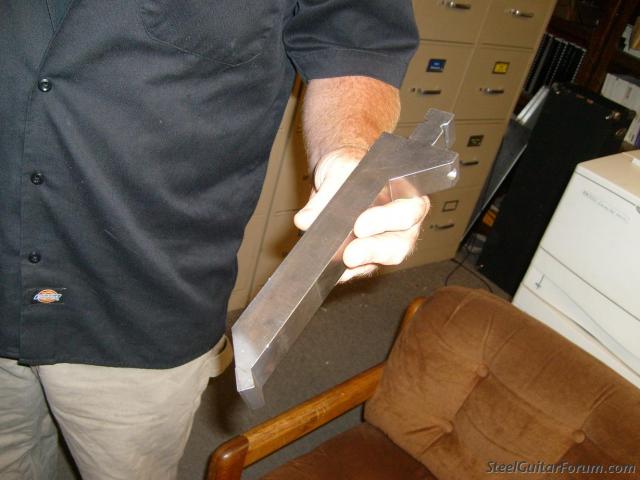
Don't be discouraged from sending suggestions. We're figuring everything out as we go along, and we're bound to end up up some blind alleys.  |
|
|
|
Philip Bender
From:
Palmetto FL USA (deceased)
|
 Posted 27 Jul 2009 11:51 am Steel guitar
Posted 27 Jul 2009 11:51 am Steel guitar |
|
Aloha Alan,
It looks like you have it figured out, so I will refrain from confusing the issue, but I sure do like your design, and would like to do one of those things, but alas I don't have the right equipment either, but after having said that, wuold you please send me the dimensions of the pan area just for doodling, please, and no I will not be building one. The wife has made me promise not to start another guitar for 1 year, so that is that.
Thanks for your help,
Phil
PS Since the bodies are parallel, how hard would it be to bolt 2, or 3 of them together? Whooops. |
|
|
|
Lem Smith
From:
Long Beach, MS
|
 Posted 28 Jul 2009 8:37 pm
Posted 28 Jul 2009 8:37 pm |
|
Alan, when I first saw that last pic of the die, I thought you had designed an oversized knee lever for your new lap steel.  |
|
|
|
Alan Brookes
From:
Brummy living in Southern California
|
 Posted 29 Jul 2009 7:03 am
Posted 29 Jul 2009 7:03 am |
|
Now that would be something like a steel. With four of those, and five or six pedals of similar robustness, all you would need is the pickup truck with a crane on the back to move it around. 
It brings to mind the suits of armour that knights used. To mount their horses they used a crane. If they were dismounted they had to struggle to get to their feet before they were jumped on.  |
|
|
|
Lem Smith
From:
Long Beach, MS
|
 Posted 29 Jul 2009 11:50 am
Posted 29 Jul 2009 11:50 am |
|
At least you wouldn't have to worry about snapping the knee lever off if you happened to hit it a little hard with your knee!   |
|
|
|
Philip Bender
From:
Palmetto FL USA (deceased)
|
 Posted 13 Aug 2009 4:01 pm Real steeel guitar
Posted 13 Aug 2009 4:01 pm Real steeel guitar |
|
Aloha Alan,
Haven't heard much from you of late, how is it going? How does the guitar sound, and are you going to build any more?
Phil |
|
|
|
Alan Brookes
From:
Brummy living in Southern California
|
 Posted 13 Aug 2009 4:22 pm
Posted 13 Aug 2009 4:22 pm |
|
Progress has been slow over the last week or two because Tom is having to fit the design work into his tight schedule. At the moment he's redesigning the 12-string version to create one with two pickups and a body that is rectangular from one end to the other, instead of having a machine head which looks like an add-on.
Tests with the prototype show a small volume compared to other lap steels, and this is caused by the gap between the strings and the pickup being too large. Since we can't heighten the pickup the strings will have to be lowered. That will also help the parallax problem. This is why I haven't done any recordings with it yet.
We're also well advanced on a 10-string instrument with GeorgeL pickups and a vertical fretboard extension, and we're thinking in terms of fret slots with LCDs(LEDs -see Mark's note) behind them.
Outside the realm of the steel guitar, I'm envisioning a hammered dulcimer in stainless steel. The main problem would be how to mount rest pins, which usually maintain their tension via wood, specifically maple.
Last edited by Alan Brookes on 14 Aug 2009 12:39 pm; edited 1 time in total |
|
|
|
Mark Bracewell
From:
Willow Glen, California
|
 Posted 13 Aug 2009 5:06 pm
Posted 13 Aug 2009 5:06 pm |
|
| Alan Brookes wrote: |
| ...and we're thinking in terms of fret slots with LCDs behind them. |
LED's would be cool, but LCD's?! Wow!
 |
|
|
|
Alan Brookes
From:
Brummy living in Southern California
|
 Posted 14 Aug 2009 12:47 pm
Posted 14 Aug 2009 12:47 pm |
|
| Mark Bracewell wrote: |
...LED's would be cool, but LCD's?! Wow!  |
Oops, a bit of brain slip there.   Yes, LEDs, of course. We're not planning on any Liquid Crystal Displays on the fingerboard, although that could be cool. If you think about it, the fingerboard could be a small computer screen, with the frets as an image. You could then connect it via a USB to your computer, and write a program which illuminates the necessary frets in the appropriate key, plus sevenths and fifths in different colors. You would type in the key you need, and sensors would determine the pitch of the strings. You could have an array of warning lights, like on a car dashboard, warning if a string is out-of-tune, or if you hit too many dischords. Yes, LEDs, of course. We're not planning on any Liquid Crystal Displays on the fingerboard, although that could be cool. If you think about it, the fingerboard could be a small computer screen, with the frets as an image. You could then connect it via a USB to your computer, and write a program which illuminates the necessary frets in the appropriate key, plus sevenths and fifths in different colors. You would type in the key you need, and sensors would determine the pitch of the strings. You could have an array of warning lights, like on a car dashboard, warning if a string is out-of-tune, or if you hit too many dischords.  |
|
|
|
Mark Bracewell
From:
Willow Glen, California
|
 Posted 14 Aug 2009 5:42 pm
Posted 14 Aug 2009 5:42 pm |
|
Yep - forget the steel app for the iPhone - instead have a phone app for your steel! Use it in the car and really give 'em a reason to pull you over  |
|
|
|
Philip Bender
From:
Palmetto FL USA (deceased)
|
 Posted 18 Aug 2009 10:19 am Steel guitar
Posted 18 Aug 2009 10:19 am Steel guitar |
|
Aloha Alan,
Well I have been doodling again, and I have an idea for you. Would you like me to send it to you via email or just bring it up here on the forum?
Phil |
|
|
|
Alan Brookes
From:
Brummy living in Southern California
|
 Posted 18 Aug 2009 4:32 pm
Posted 18 Aug 2009 4:32 pm |
|
| ...unless it's a commercial proposition, bring it up on the Forum. |
|
|
|
Philip Bender
From:
Palmetto FL USA (deceased)
|
 Posted 20 Aug 2009 4:56 am Tuning head idea
Posted 20 Aug 2009 4:56 am Tuning head idea |
|
Aloha Alan,
Well here goes, I took one of your pictures of the tuner head which was upside down, and a light came on in my little brain. If you turned the head upside down, and cut elongated holes for the strings to pass through, and installed the tuner machines on the inside of the pan, it would clean up the appearance a little.
To take it a step further, you could modify the tuners, to allow them to be adjusted through another hole in the pan.
Sketches to follow if you are interested.
Phil |
|
|
|



